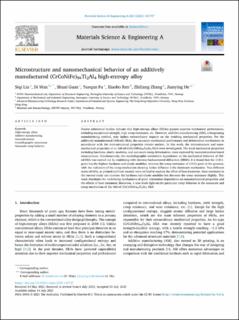| dc.description.abstract | Recent substantial studies indicate that high-entropy alloys (HEAs) possess superior mechanical performance, including exceptional strength, high creep resistance, etc. However, additive manufacturing (AM), a burgeoning manufacturing method, may induce extraordinary impacts on the resulting mechanical properties. For the additively manufactured (AM-ed) HEAs, the nanoscale mechanical performance and deformation mechanisms in accordance with the microstructural properties remain unclear. In this work, the microstructure and nanomechanical properties of an AM-ed (CrCoNiFe)94Ti2Al4 HEA were investigated. The local mechanical properties including hardness, elastic modulus, and nanoscale creep deformation, were explored by nanoindentation-based measurement. Simultaneously, the crystallographic orientation dependence on the mechanical behavior of AM-ed HEA was carried out by combining with electron backscattered diffraction (EBSD). It is found that the {101}-grain has the highest hardness and elastic modulus, whereas the creep resistance of {111}-grain is the greatest, with the indicators of the creep mechanism showing lattice diffusion is the dominant mechanism. Two different states of HEA, as-printed and heat-treated, were utilized to explore the effect of heat treatment. Heat treatment in the current study can increase the hardness and elastic modulus but decrease the creep resistance slightly. This work elucidates the underlying mechanisms of grain orientation dependence on nanomechanical properties and the effects of heat treatment. Moreover, it also sheds light on the particular creep behavior at the nanoscale and creep mechanism of the AM-ed (CrCoNiFe)94Ti2Al4 HEA. | en_US |

